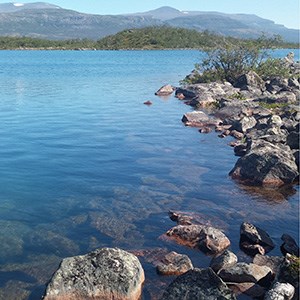Contact
Department of Aquatic Sciences and Assessment, Division of Ecology and Biodiversity

ARCWEB is a research project aiming to investigate the oligotrophication-induced taxonomic and biochemical changes in basal resources of Arctic/alpine lakes in Sweden, and the consequences of these changes for consumers at multiple trophic levels.
Swedish Arctic/alpine lakes are undergoing drastic oligotrophication, i.e. declines in ambient nutrients (nitrogen (N) and phosphorus (P)), due to ongoing climate-driven shifts in catchment processes including
The concerted action of these large-scale changes has transformed the clear-water, nutrient-poor northern lakes toward ultra-oligotrophic, more N-limited conditions that affect the benthic algal communities, which predominate primary production and form the base of food webs in these lakes. The benthic algal communities are expected to shift toward an increased predominance of N2-fixing cyanobacteria upon oligotrophication. As cyanobacteria are a poor food source and potentially produce toxins, these changes in basal resources have expected, yet unknown, repercussions on invertebrate consumers and fish.
Objectives of ARCWEB are to:
ARCWEB will use a combination of field and lab studies to quantify the depth distribution, cyanotoxin production, and trophic importance of cyanobacteria in Swedish Arctic/alpine lakes across gradients in water nutrient concentrations and N:P ratios. Novel fatty acid-based models, compound-specific stable isotope analysis, and isotope mixing models will be used to infer oligotrophication-induced changes in basal resources for invertebrates and fish, and the subsequent impacts on biochemical nutritional quality, growth, and trophic pathways of consumers. ARCWEB will produce new knowledge on oligotrophication effects and develop tools (e.g. indicators of cyanobacteria dominance and food-web consequences) for assessing impacts of these effects on Arctic/alpine lakes.
Ann-Kristin Bergström, Umeå University, Sweden
Kirsten Christoffersen, University of Copenhagen, Denmark
Martin Kainz, WasserCluster Lunz, Austria
ARCWEB is funded by the Swedish Research Council for Environment, Agricultural Sciences and Spatial Planning (FORMAS).